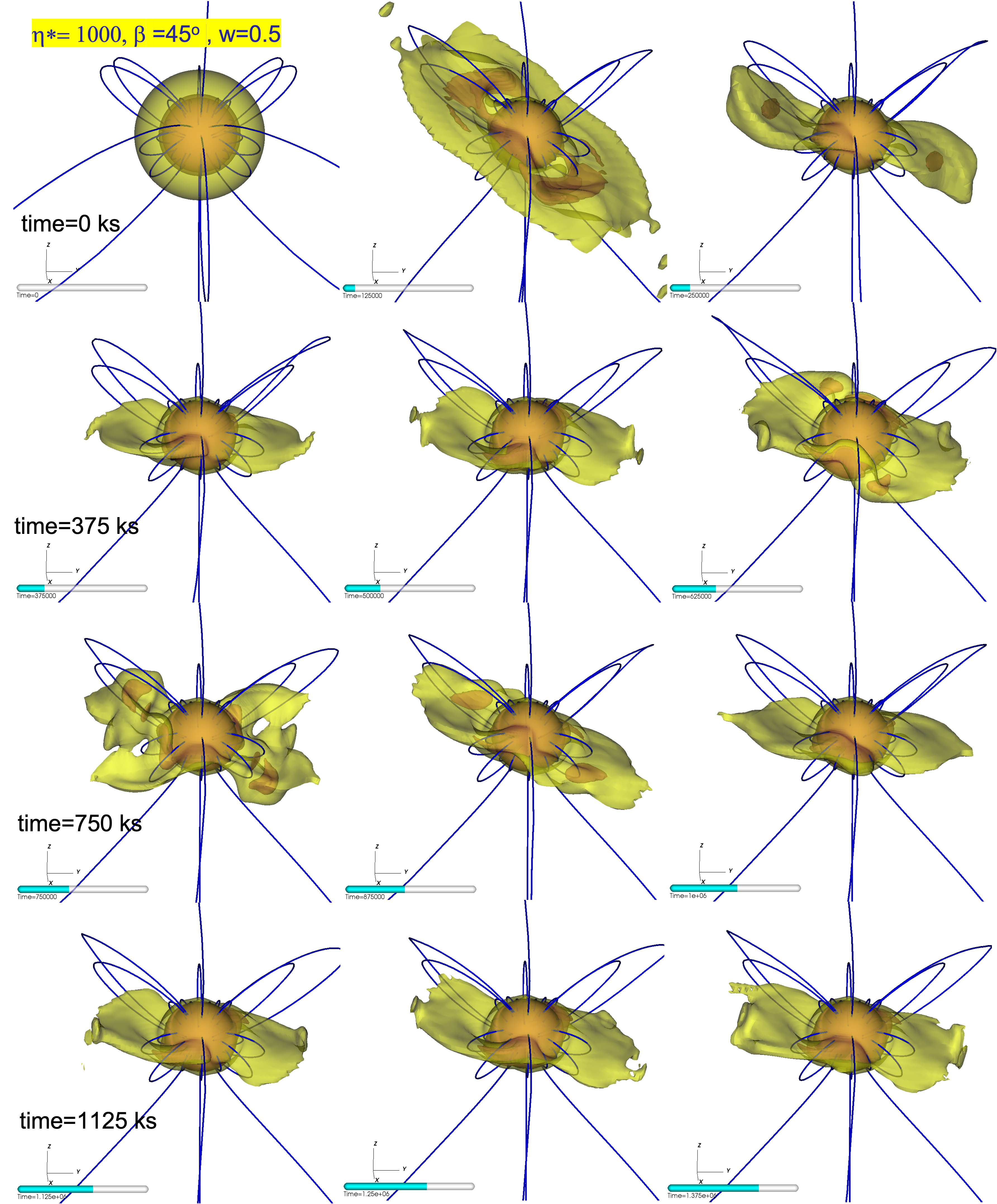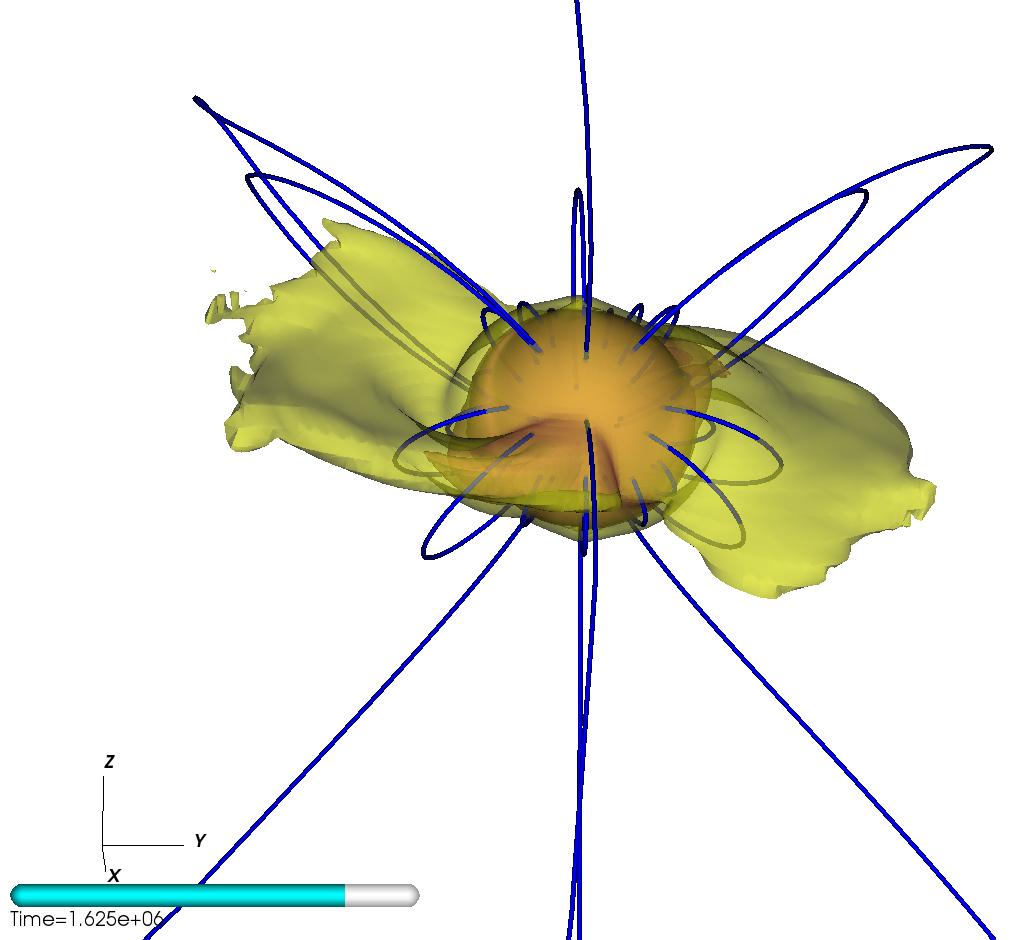By Neha Srinivasan and Kimberly Mann Bruch, San Diego Supercomputer Center, and Ken Chiacchia, PSC

Distribution of gas trapped by simulated stars’ magnetic fields, comparing stars whose magnetic poles are nearly aligned with their rotation (left) vs. one in which the field is tilted (right). The top row shows a view from above the star’s rotational pole, while the bottom shows views along the equator at three different times of the star’s rotation period. Credit: Pennsylvania State University at Scranton
Mismatch of Magnetosphere and Axis of Rotation Offers Insight into Solar Winds and Disruptive Flares
WHY IT’S IMPORTANT
The magnetosphere — the region around the Earth dominated by the planet’s magnetic field — shields us from harmful solar and cosmic particle radiation. The magnetosphere also prevents the solar wind from blowing Earth’s atmosphere into space.
The Sun also has a magnetic field. The solar wind occurs in the Sun’s magnetosphere when charged particles suddenly explode from the corona, its outermost layer. This flings particles along the magnetic field lines of the sun at immense speed, creating a solar flare. These flares can disrupt communications and threaten the safety of any astronauts traveling outside the protection of the Earth’s magnetosphere.
“… a better understanding of the magnetosphere helps improve our space weather models, thereby improving our understanding of the Universe as a whole. Powerful solar winds can have detrimental effects on cell phone communication, GPS systems, space technologies, and internet services.” — Asif ud-Doula, Penn State
The poles of the Earth’s magnetic field are close to aligning with its axis of rotation, but not quite. That’s why, over most of the planet, a compass needle points (almost) toward the north pole. The Sun’s magnetic field is even closer to perfect alignment with its rotation. But the magnetic pole of many stars other than the Sun can be extremely far off from their rotational axis. If you could stand on the surface of one of these stars, a compass wouldn’t point anywhere near the star’s north pole. This misalignment of a star’s magnetic pole from its rotational axis creates a magnetosphere with a very complex three-dimensional structure.
A better understanding of the structure of these 3D magnetic fields and the processes that create them offers improvements in our understanding of the Sun’s and the Earth’s less chaotic fields. It would also help us understand how we could protect ourselves from the effects of solar flares. To accomplish this, Asif ud-Doula and his team at the Pennsylvania State University at Scranton wanted to simulate chaotic stellar magnetic fields at a high level of detail. His tool of choice for the work was the Bridges-2 supercomputer at PSC. The team acquired time on Bridges-2 via the ACCESS network of NSF-funded high performance computing systems.
HOW PSC HELPED
The Penn State team used Bridges-2 to produce and analyze different magnetosphere models. The central aim of the study was to use 3D simulations to characterize and possibly predict the complex magnetosphere structures of rapidly rotating, hot stars. To achieve this, the team compared the magnetosphere of such stars that have different tilt angles, which is the angle between the magnetic axis and rotational axis of a star.
The scientists compared 3D computer simulations of magnetosphere structures of two different hypothetical stars. One’s magnetic pole was nearly aligned to its rotational axis, with a tilt angle of five degrees. The other’s magnetic pole slanted much more, with a tilt angle of 45 degrees. The data demands of these computations were vast, requiring multiple simulations, each of which required at least 60,000 CPU hours.
“Each 3D computer model requires substantial computing time that is equivalent to running a single computer continuously for about seven years — so, parallel or supercomputing is a necessity. Accessing a supercomputer can be highly expensive, but luckily ACCESS gives us an opportunity to use [Bridges-2] at no expense. Without such an access, our study would have been difficult to accomplish.” — Asif ud-Doula, Penn State

Trapped material structure along with a star’s magnetic field lines can be stretched by the weight of the material. Credit: Pennsylvania State University at Scranton
The simulations successfully showed how the two stars’ magnetic fields arose, and how their differing tilt angles affected them. One important discovery was that the buildup of gas trapped by the more tilted star’s magnetic field can distort the field. The result is an unstable, highly active field that would likely produce more and more intense stellar winds and flares than those of the Sun. The team reported their results in the journal Monthly Notices of the Royal Astronomical Society in February 2023.
The Penn State scientists next plan to explore a broader range of tilt angles, including the extreme case of a fully titled magnetic pole at 90 degrees. Such stars’ magnetic poles would lie on opposite sides of their equators, spinning around like a lighthouse. The collaborators expect this simulation to be challenging, as a 90-degree tilt angle will have the most complex magnetosphere structure of all. Other next steps include using the current results to predict changes in a magnetosphere, such as emission from trapped hydrogen atoms, or X-rays from gas heated by trapping of stellar wind outflows.
